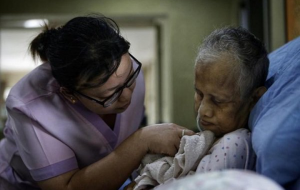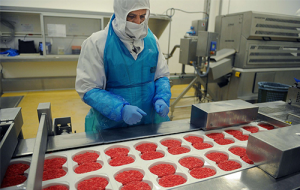Infection Prevention: Environmental Cleaning and Practical Infection Control
Recent events in the US healthcare industry have combined to create a rush by healthcare facilities toward the adoption of technology for total room disinfection. Events include: 1) changes to the Affordable Care Act that reduced CMS and insurer compensation to hospitals due to high rates of Healthcare Acquired Infections (HAIs); 2) elimination of CMS and insurer reimbursements to hospitals for individual patient healthcare costs if and when a patient develops an HAI; 3) a number of peer-reviewed publications of total room disinfection systems used at terminal discharge demonstrating successful reductions of either bioburden or HAIs or both; 4) presenter advocacy at recent infection prevention professional conferences including American Prevention and Infection Control (APIC) and Society of Healthcare Epidemiology of America (SHEA); 5) industry innovation; and 6) industry promotion.
In the ensuing market competition between hydrogen peroxide vapor (HPV) fogging and UV total room disinfection systems, UV appears to be the leader in the U.S., likely for reasons of speed, safety and ease of use19. Well-trained housekeeping staff can completely disinfect 20 to 50 patient rooms per day depending on the speed of the mobile UV system chosen. The faster the disinfection system, the faster the room turnaround, and the greater the improvement in hospital revenue; the less EVS staff time required, the lower the hospital operational costs; and there is no risk to staff or patients of exposure to residual aerosol disinfectant.
Of the two types of energy-based disinfection systems being marketed today, UVC has been a proven technology for disinfecting air, water and instruments for over a century2,3. UVC is a narrow spectrum technology operating at a frequency of 254 nm, very close to the optimal germicidal frequency (263 nm to 266 nm) for bacterial and viral disinfection.
PX light is a broad-spectrum technology developed in the 1950s primarily for flash photography. PX does however include some germicidal UV in its range of emitted light frequencies.
Efficiency
Narrow spectrum UVC emitters are relatively efficient at generating germicidal UV with a known range of efficiency from 24% to 38%. That means a bulb rated for 100 W input power from one manufacturer may emit 24 W of germicidal UV, while a 100 W bulb from another device manufacturer may produce as much as 38 W of germicidal radiation. Technologies known to impact this range include tubing materials, and temperature management. Further optimization of emission of UV energy onto surfaces can be accomplished with reflectance technology.
By contrast, PX bulbs are relatively inefficient at generating germicidal UV with a published efficiency of just 9%. Much of the input energy is wasted as heat and visible light, rather than being converted to germicidal UV. Consequently, for any given input power, a UVC lamp will emit approximately 4 times more germicidal UV than its PX counterpart.
Given the example of a typical US hospital receptacle that supplies up to 2000 watts of electrical power, the maximum germicidal UV output of a PX device can only be 180 Watts (9 % x 2000 watts = 180 watts), whereas a UVC device can generate 760 Watt of germicidal UV (38% x 2000 watts = 760 watts).
Disinfection efficiency is a direct function of the delivered germicidal UV power and exposure time. Therefore, it becomes quite clear that UVC can disinfect up to 4 times faster, or 4 times more, than a PX device from a single emitter using the same power (760 watts / 180 watts = 4.2X).
Efficacy
UVC constants have been published for all bacteria and viruses allowing easy calculation of time and power required for deactivation with germicidal UV. Disinfection constants vary greatly with the organism. In general, vegetative bacteria are deactivated very quickly, spores require a lot more time.


At a UVC energy dose of 400 mJ/cm2, all known epidemiologically important pathogens (EIP), including Clostridium difficile spores, are rendered inert. Germicidal UV creates thymine-thymine dimers and thymine-cytosine dimers of neighboring molecules on strands of DNA and RNA, preventing organism replication.
The higher the emitted energy of the device, the faster the target energy dose is reached, and the faster the disinfection cycle. For example, if the device emitted 400 mJ/cm2/minute at the target distance, only one minute of operation would be required for disinfection. If the device emitted 40 mJ/cm2/minute (more commonly expressed as 0.667 mJ/cm2/s i.e. 0.667 mW/cm2) at the target distance, then 10 minutes would be required to achieve the same disinfection dose.

Life Cycle / Maintenance:
The life of a PX bulb is counted by the number of pulses it can sustain before the electrodes are destroyed. Typical published values for PX life-cycle range from 1 to 10 million pulses. Assuming an average life cycle of 5 million pulses, and a flash rate of 3 times per second, (the value reported by one PX manufacturer), this will only result in an expected life of 463 hours. (5 million / 3 = 1.67 million seconds = 463 hrs.) Given that a typical disinfection cycle lasts 15 minutes according to one PX manufacturer, this means that the PX lamp will need to be replaced after 1,852 cycles. Assuming the PX unit is used 20 times per day, then the PX lamps will need to be replaced every 3 months.
By comparison, the published life expectancy of a typical UVC lamp is between 10,000 and 17,000 hours. For at least one manufacturer, that could mean bulb replacement as little as every 5 years.
Operational & Proximity Safety:
Because of their inherent high temperature flash operating mode, PX lamp surfaces become extremely hot (1000 oC) and may become a fire hazard or cause severe injuries if accidentally touched after discharge (similar to a burnt flash bulb from a 1950s flash camera). In addition, the gas pressure that builds up inside the hot lamp becomes pressurized to several atmospheres and can explode violently projecting glass debris. This may be the reason at least one PX manufacturer retracts the PX lamps into a protective canister immediately after discharge.
Viewing Safety:
UVC can be safely and comfortably viewed from behind glass. UVC does not penetrate glass or plastics. This allows high visibility of the disinfection process in glass-walled areas like ICU.
Conversely, PX devices discharge an intensely bright fast-paced strobe of visible light. Staff need to be trained to protect patients, visitors and staff from accidentally viewing the device through glass while in operation. This may require installation of additional curtains or blinds, as well as training of EVS staff and clinical staff working in commonly glassed areas such as ICU. Even casual contact walking beside partially covered glass can subject passersby to discomfort from the intense white light flash.
Mercury:
At least one PX manufacturer promotes the fact their product does not contain mercury. True. Conversely, UVC lamps do contain a tiny amount of mercury, the same as every fluorescent lamp used throughout hospitals, commercial and industrial buildings and residences all over the world. The amount of gaseous mercury that could be released from a broken UVC lamp in a hospital is much too low to create a health risk. Many manufacturers also encapsulate their lamps in a protective Teflon sleeve that both eliminates any possible release of mercury vapor and serves to protect occupants from exposure to fragments of broken glass in the event of breakage.
Discussion
Optimization:
All light energy, whether visible or invisible, UV or non-UV, UVC or PX, follows an inverse square law. If the distance from the point source to the target doubles, the energy decreases to 25%. Conversely, if the distance to target is halved, the energy density quadruples. Thus whether using 9% efficient PX or 38% efficient UVC, using two emitters instead of one would cut the distance to target for all surfaces in half and would reduce the room disinfection time by 75%.
A further effectiveness optimization strategy would be to locate the two emitters equidistant on either side of the patient bed with an overlap pattern of UV emission and set to achieve a Log6 reduction on the most distant outer wall surface. This would double the germicidal UV in the vicinity of the patient bed between the emitters, the most critical area in the room, and provide up to a Log12 reduction. Adding additional emitters would shorten room disinfection time even further but the law of diminishing returns would suggest two to three emitters is optimum.
Conclusion
Both UVC and PX have been shown to dramatically reduce bioburden and HAIs. However, UVC appears to be 4 times more energy efficient than PX, and 4 times faster or more effective than PX. UVC appears to provide 10 times longer lamp life and dramatically lower life cycle costs than PX. UVC does not expose staff to the risk of contact with excessively high temperature, or exploded lamps that PX may. UVC can be safely and comfortably viewed while in operation from behind glass or plastic whereas PX presents a risk of temporary blinding or discomfort for passersby.
All germicidal UV systems can substantially shorten room disinfection times and optimize room turnaround using two or three emitters.
UVC appears to offer significant technological, operational, safety and cost advantages over PX. Perhaps that is why UVC is the predominant air, water and surface disinfection technology used in all other industries. There are millions of UVC installations worldwide and no apparent movement afoot in any industry to switch from UVC to PX. The market share for UVC in other industries is likely in the order of 99.99%. Perhaps we should pause to consider that context, as well as the safety, operation, efficiency, efficacy, life-cycle and maintenance costs, when we consider our options for germicidal UV surface disinfection for healthcare.
References
- Koutchma,T., Orlovska,M.,Zhu,Y., UV light for fruits and fruit products, Agriculture and Agri-Food Canada, Guelph Food Research Center,. p.69, table 2.2.
- Schaefer,R., Grapperhaus, M. New Surface Discharge Pulsed UV light source C-1,Third International Congress on Utraviolet Technologies, Whistler, 2005.
- Schaefer,R., Grapperhaus, M., Schaefer, I., Linden,K. Pulsed UV lamp Performance and Comparison with UV Mercury Lamps Environ. Eng. Sci. Vol. 6 pp. 303-310 , 2007.
- Nerandzic, M., Thota,P., et ali, Evaluation of a Pulsed Xenon Ultraviolet Disinfection System for Reduction of Healthcare-Associated Pathogens in Hospital Rooms. Infection Control & Hospital Epidemiology, February 2015, Vol.36, no.2.
- Reed, N.G. The History of Ultraviolet Germicidal Irradiation for Air Disinfection Public Health Rep. 2010 Jan-Feb; 125(1): 15–27.
- https://en.wikipedia.org/wiki/Ultraviolet_germicidal_irradiation
- Block, S.S. Disinfection, Sterilization, and Preservation Lippincott Williams & Wilkins 5th Edition 2001
- Hurst, C.J. Modelling Disease transmission and its prevention by disinfection Cambridge University Press 1996
- Bolton, J.R., Cotton, C.A. The Ultraviolet Disinfection Handbook American Water Works Association 2008
- Huang, S.S., Datta, R., Platt, R. 2006. Risk of acquiring antibiotic-resistant bacteria from prior room occupants. Archives of Internal Medicine. 166(18), 1945-1951.
- Drees, M., Snydman, D.R., Schmid, C.H., Barefoot, L., Hansjosten, K., Vue, P.M., Cronin, M., Nasraway, S.A., Golan, Y. 2008. Prior environmental contamination increases the risk of acquisition of vancomycin-resistant enterococci. Clinical Infectious Diseases. 46(5), 678-685.
- Hamel, M., Zoutman, D., O’Callaghan, C. 2010. Exposure to hospital roommates as a risk factor for health care-associated infection. American Journal of Infection Control. 38(3), 173-181.
- Otter, J.A., Yezli, S., Salkeld, J.A., French G.L. 2013. Evidence that contaminated surfaces contribute to the transmission of hospital pathogens and an overview of strategies to address contaminated surfaces in hospital settings. American Journal of Infection Control. 41(5 Suppl), S6-S11.
- Huslage, K., Rutala, W.A., Gergen, M.F., Sickbert-Bennett, E.E., Weber, D.J. 2013. Microbial assessment of high-, medium-, and low-touch hospital room surfaces. Infection Control & Hospital Epidemiology. 34(2), 211-212.
- Stiefel, U., Cadnum, J.L., Eckstein, B.C. Guerrero, D.M., Tima, M.A., Donskey, C.J. 2011. Contamination of hands with methicillin-resistant Staphylococcus aureus after contact with environmental surfaces and after contact with the skin of colonized patients. Infection Control & Hospital Epidemiology. 32(2), 185-187.
- Morgan, D.J., Rogawaski, E., Thom, K.A., Johnson, J.K., Perencevich, E.N., Shardell, M., Leekha, S., Harris, A.D. 2012. Transfer of multidrug-resistant bacteria to healthcare workers’ gloves and gowns after patient contact increases with environmental contamination. Critical Care Medicine. 40(4), 1045-1051.
- Hayden, M.K., Blom, D.W., Lyle, E.A., Moore, C.G., Weinstein, R.A. 2008. Risk of hand or glove contamination after contact with patients colonized with vancomycin-resistant enterococcus or the colonized patients’ environment. Infection Control & Hospital Epidemiology. 29(2), 149-154.
- Carling, P.C., Parry, M.F., Bruno-Murtha, L.A., Dick, B. 2010. Improving environmental hygiene in 27 intensive care units to decrease multidrug-resistant bacterial transmission. Critical Care Medicine. 38(4), 1054-1059.
- Nerandzic, M., Cadnum, J.L., Pultz, M.J., Donskey, C.J. Evaluation of an automated ultraviolet radiation device for decontamination of Clostridium difficile and other healthcare-associated pathogens in hospital rooms. BMC Infect Dis. 2010 ; 10: 197
- Anderson D.J., Gergen M.F., Smathers, E., Sexton D.J., Chen L.F., Weber, D.J., Rutala, W.A. and CDC Prevention Epicenters Program. Decontamination of Targeted Pathogens from Patient Rooms Using an Automated Ultraviolet-CEmitting Device. Infect Control Hosp Epidemiol. 2013 May ; 34(5): 466–471.
- Levin, J., Riley, L.S., Parrish, C., English, D., Ahn, S. The effect of portable pulsed xenon ultraviolet light after terminal cleaning on hospital-associated Clostridium difficile infection in a community hospital. American Journal of Infection Control August 2013Volume 41, Issue 8, Pages 746–748
- Simmons, S., Morgan, M., Hopkins, T., Helsabeck, K., Stachowiak, J., Stibich, M. Impact of a multi-hospital intervention utilising screening, hand hygiene education and pulsed xenon ultraviolet (PX-UV) on the rate of hospital associated methicillin resistant Staphylococcus aureus infection. Journal of Infection Prevention September 2013 vol. 14 no. 5 172-174
- CADTH 2015. Rapid response report: Summary of abstracts. Environmentally active agents for infection prevention in health care facilities: Clinical effectiveness, cost-effectiveness, and guidelines.
- Andersen, D., Chen L. F., Weber D.J., Moehring R.W., Lewis S.S., Triplett P., Blocker M., Becherer P., Schwab J.C., Knelson L.P., Lokhnygina Y. Rutala W., Sexton D.J., CDC Epicenters Program, Duke Infection Control Outreach Network, Duke University Medical Center, University of North Carolina Health Care, High Point Regional Health System, Alamance Regional Health Center, Rex Healthcare, Chesapeake Regional Healthcare, Duke University. 2015 The Benefits of Enhanced Terminal Room (BETR) Disinfection Study: A Cluster Randomized, Multicenter Crossover Study with 2×2 Factorial Design to Evaluate the Impact of Enhanced Terminal Room Disinfection on Acquisition and Infection Caused by Multidrug-Resistant Organisms (MDRO). SHEA Featured Abstract Society of Healthcare Epidemiology of America, IDWeek October 9, 2015, San Diego, California.
HEADQUATERS
PG35, Damansara Perdana Shopping Centre, Jalan PJU 8/1, 47820, Petaling Jaya, Selangor, Malaysia
TEL : 0377332757 EMAIL:info@ansrcare.com
BRANCH
Lot 3484 B, Tingkat Bawah Wisma Seri Panji Alam Jalan Panji Alam 21100 Kuala Terengganu, Terengganu Darul Iman.
TEL:096229270 EMAIL:info@ansrcare.com
ANSRCARE.COM © 2018, All Rights Reserved. Web Design By BG Design







